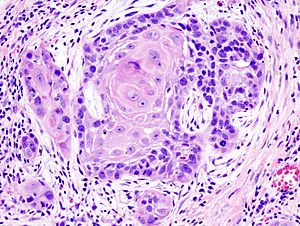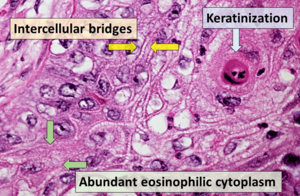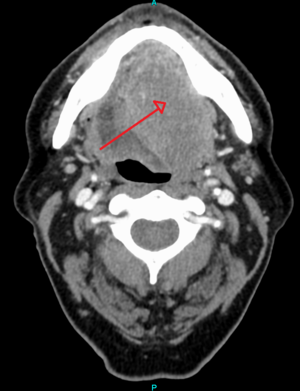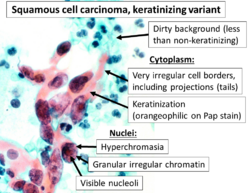Squamous-cell carcinoma facts for kids
Squamous-cell carcinoma (say: SKWAY-mus-sell car-sin-OH-ma), or SCC, is a type of cancer. It starts in special cells called squamous cells. These flat cells are found on the surface of your skin, inside hollow organs, and lining your breathing and digestive tubes.
Some common types of SCC include:
- Cancer of the esophagus (the tube that carries food to your stomach)
- Skin cancer
- Lung cancer
- Thyroid cancer (a gland in your neck)
Even though they all have "squamous-cell carcinoma" in their name, these cancers can act differently. They might show different signs, grow in different ways, have different outlooks, and need different treatments.
Contents
Where SCC Can Grow
Squamous-cell carcinoma can appear in many parts of the body. Let's look at some of the most common places.
Head and Neck Areas
About 9 out of 10 cancers in the mouth, nose, throat, and nearby areas are SCC. The human papillomavirus (HPV) can sometimes be linked to SCCs in the throat.
Skin
Cutaneous squamous-cell carcinoma is the second most common type of skin cancer. In the United States, over a million cases are found each year.
Thyroid Gland
When SCC starts in the thyroid gland, it can be very aggressive. This means it grows quickly and can be hard to treat, leading to a poor outlook for patients.
Esophagus
Esophageal cancer can be SCC or another type called adenocarcinoma. SCCs usually form closer to the mouth, while adenocarcinomas are closer to the stomach.
Common signs include trouble swallowing, especially solid foods. Painful swallowing can also happen. If the cancer is only in one spot, doctors might remove that part of the esophagus. If it has spread, treatments like chemotherapy and radiotherapy are often used.
Lungs
Squamous-cell carcinoma of the lung often starts in the center of the lungs. It is a type of non-small-cell lung cancer. Smoking is the main cause of this type of lung cancer.
Prostate Gland
When SCC affects the prostate gland (a gland in men), it is very aggressive. It's hard to find early because it doesn't cause a rise in PSA levels. This often means it's found at a later stage.
Bladder
Most bladder cancers are a different type. However, bladder cancer linked to a parasite infection called schistosomiasis is often SCC.
How Doctors Find SCC

Doctors usually start by asking about your health history and doing a physical exam. They might also use scans to look inside your body.
To be sure it's SCC, doctors usually take a small piece of tissue, called a biopsy. This tissue is then looked at under a microscope by a specialist. This helps them make a clear diagnosis.
Understanding Cancer Growth
Cancer is a very large group of diseases. SCCs are one of the biggest groups within them. All SCCs are thought to begin when cancer stem cells in the epithelial tissue start dividing over and over without control.
Squamous cells are flat cells that line many parts of the body. When these cancer cells build up, they form a tiny area of abnormal cells. At first, these cells stay in one spot. This is called squamous-cell carcinoma in situ. It means the tumor has not yet broken through its original layer to spread.
Once the tumor grows and breaks through this layer, it is called "invasive" squamous-cell carcinoma. When a carcinoma becomes invasive, it can spread to other organs. This spread creates new tumors, called secondary tumors.
Types of SCC Under the Microscope
Doctors can classify SCCs by how they look under a microscope. Some types include:
- Adenoid squamous-cell carcinoma: This type has a tube-like pattern and certain cell changes.
- Basaloid squamous-cell carcinoma: Often found in the tongue, tonsils, or voice box, but can also be in the lung or other places.
- Clear-cell squamous-cell carcinoma: The cells look clear because they are swollen with water.
- Spindle-cell squamous-cell carcinoma: The cells are long and thin, like spindles.
- Signet ring-cell squamous-cell carcinoma: These cells have a large empty space that pushes the cell's center to one side, making them look like a signet ring.
Preventing SCC
Some studies suggest that what you eat might affect your risk of skin cancers, including SCC. Eating high-fat dairy foods might increase the risk of SCC tumors for people who have had skin cancer before.
Eating green leafy vegetables, raw vegetables, and fruits may help protect against SCC. On the other hand, consuming whole milk, yogurt, and cheese might increase SCC risk in some people. A diet high in meat and fat can also raise the risk of SCC, especially for those with a history of skin cancer. Smoking tobacco also significantly increases the risk of SCC.
See also
 In Spanish: Carcinoma espinocelular para niños
In Spanish: Carcinoma espinocelular para niños









